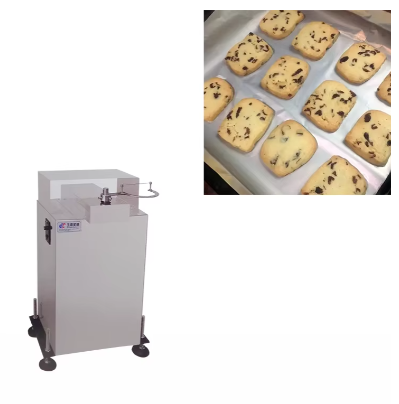Dough Consistency and Feeding Issues
Adjusting Dough Moisture Levels
The proper moisture balance in a cookie dough is critically important because it has such a dramatic effect on a cookie's texture and bake. Well-hydrated dough is key to cookies baking up evenly and the way you want, chewy or crisp. Fluctuations in atmospheric moisture can have a dramatic effect on the water content of bread dough, forcing the baker to adjust the water content of the dough on an as-needed basis. For example, on humid days you may need a little less water, and on dry days, a little more to achieve the same dough texture. Hygrometers can be a good way to ensure, by measurement of and adjustment to moisture levels, the same great quality day after day – batch after batch, so become an integral tool in any precision bakery operation.
Calibrating the Feeding Mechanism
The accurate calibration of the feeding device chucks in the chocolate chipper or the cookie machines is crucial in achieving consistent dough flow rates, and hence consistent cookies. This setting relates to setting them for different kinds of foods and of course you have to change it depending on the type of ingredients used because if not, they can over feed or under feed the dough. Standard modifications may involve varying the speed of the mechanism and/or the size of the aperture to suit particular dough textures. Information provided by manufacturers suggests that properly adjusted feed mechanisms can have a salutary effect on a shop’s productivity by minimizing wastage, while improving the quality of the finished piece. Correct calibration does not only ensure better performance, it will also extend the lifetime of the machine by avoiding unnecessary load on components.
Mechanical Jams and Component Malfunctions
Mechanical jams may occur during operation of chocolate chip cookie machines and may cause injury to the operator. Great attention should be paid to safety to avoid the injuries during the operations. Following explicit procedures can address jams without compromising the safety of personnel or machine. Frequent check-ups and early maintenance can help prevent the many stops to clear a jam during production. We take preventative measures in equipment maintenance to help protect our machines and production levels.
In maintaining the flow of production, it’s essential to systematically unclog blockages in chocolate chip cookie machines. By using a step-by-step process you can clear the jammed areas without damaging the equipment. First, turn off the machine and disconnect the power supply for safety. Then, equally carefully, take out any panels blocking your view of the interior of the machine. After you find the blockage, manually remove it with a tool that won't damage the mechanic nature of the machine. This is where having a regular cleaning and maintenance regimen is so important for minimizing blockages and maintaining an efficient operation.
Replacing Worn or Damaged Parts
The proper operation and service life of the chocolate chip cookie maker depends on the timely replacement of the machine parts that wear and tear away. Typical "wear" components incluse gears, rollers and belts, and these may become visibly damaged, have decreased output, or fail to support the retarding effort. Knowing when to service these components can prevent costly downtime. Before determining whether to repair or replace a part, a part’s condition – cracks, excessive wear, or broken parts altogether – may call for an outright replacement. Leading users through these assessments to ensure that machines will remain productive and reliable.
Knowing the industry norms for how long to replace components will help to keep your equipment running strong. By allowing used parts to wear, the efficiency of operation can be affected. Many recommend periodic checks and change outs based on just how much you use your equipment (if you find that your cones are yellowing in the sunlight then change them out much more frequently). Adhering to these principles can minimize the production risks of part failures and keep a stable margin in the production efficiency. CLICK HERE AND ORDER NOW Timely replacement of machine parts allows your chocolate chip cookie machine to work the best providing top quality product with minimum down time.
Temperature Control and Baking Irregularities
Calibrating Heating Elements
Proper calibration of the heating elements in chocolate chip cookie machines is crucial for ensuring consistent baking results. Inaccurate calibration can lead to uneven baking and affect the texture and quality of the cookies. Here's how you can identify issues with heating efficiency:
- **Identify Issues**: Look for signs like unevenly baked cookies, which might indicate that your heating elements need recalibration.
- **Recalibration Methods**: Perform recalibration by using an oven thermometer to check and adjust the temperature according to expert recommendations for chocolate chip cookies, typically between 350°F and 375°F.
Ensuring accurate calibration not only improves baking consistency but also enhances the overall efficiency of your production process.
Monitoring Oven Temperature Consistency
Temperature fluctuations can greatly impact the quality of chocolate chip cookies, causing issues like uneven baking or tough textures. Consistent oven temperature is key to achieving uniform results:
- **Impact of Fluctuations**: Variations in temperature can lead to overbaked or underbaked cookies, affecting their quality and appeal.
- **Monitoring Tools**: Utilize tools such as digital oven thermometers and probes for continuous monitoring of temperatures during production.
Successful commercial bakeries often employ these techniques to maintain the consistency and quality of their baked goods. Practices such as regular temperature checks and adjusting settings according to specific recipes can help achieve consistent results.
Preventing Contamination in Production
Implementing Metal Detection Systems
Metal detection solutions are vital in guaranteeing the safety and quality of chocolate chip cookies. These systems are also essential in protecting the processing environment by identifying and expelling metallic contaminants which accidentally enter the food process in your production line. If you are considering which metal detector to purchase optimal factors are the size, sensitivity and how it is easily integrated to your current production lines. And the best-performing systems need to be capable of detecting even the tiniest metal particulates, without compromising your production. Compliance with regulations, including those such as ISO or FDA certification must also be considered in order to conform with the food safety requirements.
Regular Equipment Sanitization Practices
Routine cleaning of equipment is important for reducing the contamination rates of chocolate chip cookies. Scheduling a sanitization plan and everything is clean everyday lessens the possibility of getting infected. Equally as important is for staff to be trained in sanitation, and supervising practices daily. For example, according to a study published in the Journal of Food Protection, routine decontamination of facilities and equipment greatly decreases the amount of harmful organisms in food-processing plants. Best practices like using food-safe sanitizers and following industry-recommended cleaning protocols can improve the disinfecting process.
In the next section, we'll delve into the significance of temperature control and how to address baking irregularities in chocolate chip cookie machines.
FAQs
Why is dough moisture important in baking?
Maintaining the right moisture balance in dough affects the texture and bake quality of cookies. Proper hydration ensures cookies bake evenly.
What should be considered when calibrating cookie machine feeding mechanisms?
Calibrate according to the ingredient density to ensure consistent dough flow rates, adjusting speed or aperture size as necessary.
How can one prevent contamination in chocolate chip cookie production?
Implement metal detection systems and regular equipment sanitization practices to reduce contamination rates.






